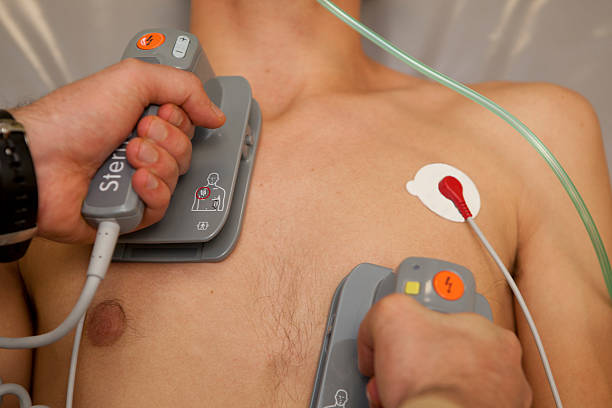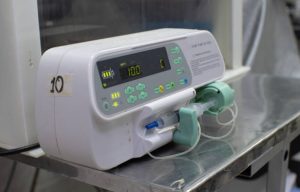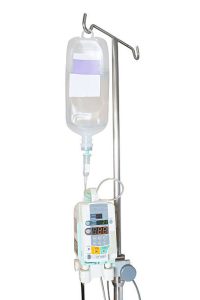
shocking a man with a defibrillator/electroshock by a doctor/paramedic that has a heart/cardiak attack in a emergency room
Defibrillator Overview
A defibrillator is a medical device used to deliver an electric shock to the heart to restore a normal rhythm during life-threatening conditions like cardiac arrest or arrhythmias.
Types of Defibrillators
- Automated External Defibrillator (AED):
- Designed for use by laypersons.
- Provides voice prompts to guide users.
- Automatically analyzes heart rhythm and advises when to shock.
- Manual Defibrillator:
- Used by trained medical personnel.
- Requires interpretation of heart rhythms and manual administration of shocks.
- Implantable Cardioverter Defibrillator (ICD):
- Surgically implanted in patients at risk of sudden cardiac arrest.
- Monitors heart rhythms and delivers shocks as needed.
- Wearable Defibrillator:
- A vest worn by patients at risk of sudden cardiac arrest.
- Monitors heart rhythms and can deliver shocks if necessary.
Popular Brands & Prices
- ZOLL AED Plus
- US Price: Around $1,500 – $2,000
- India Price: ₹1.5 – 2 lakh
- Value for Money: Known for its user-friendly design and comprehensive CPR feedback.
- Philips HeartStart OnSite AED
- US Price: Approximately $1,200 – $1,600
- India Price: ₹1 – 1.5 lakh
- Value for Money: Compact, lightweight, and reliable, making it ideal for public places.
- Lifepak CR2
- US Price: Around $1,800 – $2,300
- India Price: ₹1.5 – 2.5 lakh
- Value for Money: Offers advanced features like Wi-Fi connectivity for device management.
- Cardiac Science Powerheart G5
- US Price: Approximately $1,400 – $1,800
- India Price: ₹1.2 – 1.8 lakh
- Value for Money: Durable design and straightforward operation make it a popular choice.
How to Use a Defibrillator
- Turn on the Device: Follow voice prompts or instructions on the device.
- Attach Electrode Pads: Place pads on the patient’s bare chest (one on the upper right chest and the other on the lower left rib).
- Analyze Heart Rhythm: Ensure no one is touching the patient while the device analyzes the rhythm.
- Deliver Shock if Advised: Press the shock button if the device indicates that a shock is needed.
- Continue CPR: After delivering a shock, continue CPR until emergency medical services arrive.
Features & Specifications
- User-Friendly Interface: Voice prompts and visual indicators to guide users.
- Automatic Rhythm Analysis: Detects whether a shock is needed.
- Portable Design: Lightweight and easy to transport.
- Battery Life: Varies by model, typically lasts 2-5 years.
- Maintenance Indicators: Alerts for battery replacement or pad expiration.
Performance
- Effectiveness: High success rates in restoring normal heart rhythms.
- Ease of Use: Designed for both trained and untrained users.
- Durability: Built to withstand various environmental conditions.
Safety
- Child-Friendly: Some models come with pediatric pads for use on children.
- Shock Delivery: Only shocks when necessary, minimizing risk to the patient and bystanders.
- Self-Checks: Regular self-testing to ensure readiness.
Pros and Cons
Pros:
- Life-Saving: Critical for treating cardiac arrest.
- Accessibility: Available in public spaces, workplaces, and homes.
- Ease of Use: Designed for use by non-medical personnel.
Cons:
- Cost: Can be expensive for personal or small business use.
- Training Required: While easy to use, some training is recommended for effective response.
- Maintenance: Requires regular checks to ensure functionality.
User Feedback/Testimonials
- ZOLL AED Plus: “The feedback during CPR is invaluable. It gives me confidence that I’m doing it right.”
- Philips HeartStart OnSite: “Super easy to use! The prompts make it accessible for anyone.”
- Lifepak CR2: “The connectivity features are a game-changer for managing multiple units.”
- Cardiac Science Powerheart G5: “Very reliable and has held up well in our facility.”
Disclaimer
Defibrillators are medical devices and should be used by trained individuals or under the guidance of emergency medical services. Always ensure proper training and knowledge of local protocols when using a defibrillator.
This overview provides essential information about defibrillators, including types, pricing, usage, and safety considerations.








